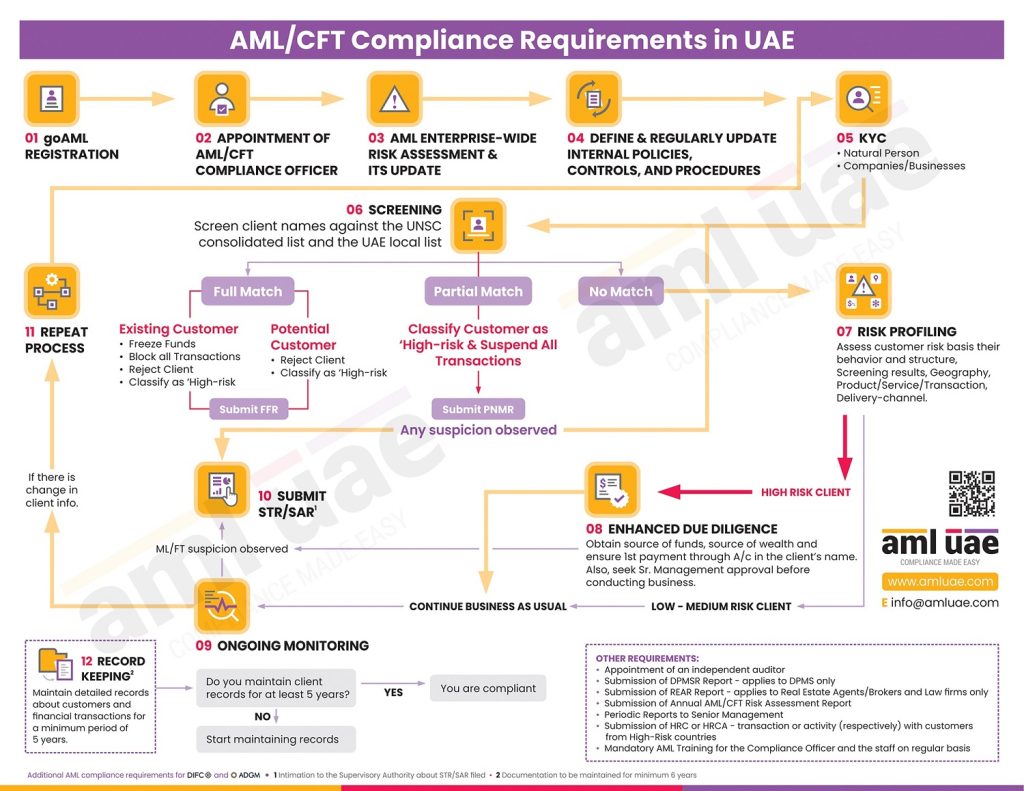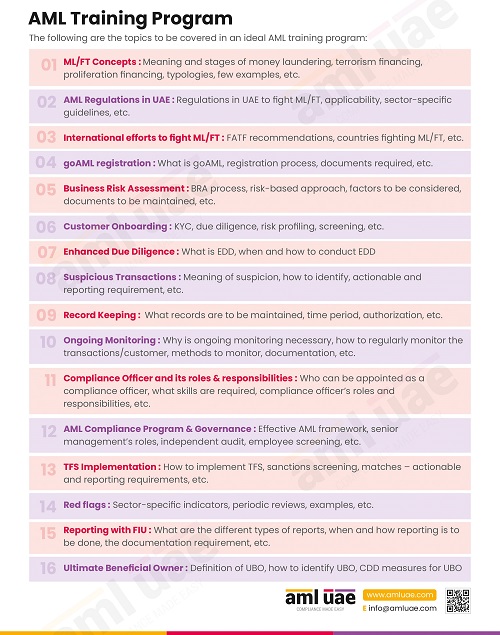How to update the AML Policies, Procedures, and Controls in line with UAE AML Laws?
In the present times, where the money laundering and terrorism financing typologies are evolving every day, the relevant regulatory frameworks are also changing regularly. In UAE, there have also been regular amendments in the Anti-Money Laundering and Combating the Financing of Terrorism (AML/CFT) regulations to extend the coverage of compliance to various industries and effectively protect the country’s economy against financial crime. It is pertinent for the regulated entities to maintain their AML Policies, Procedures, and Controls documentation up to date with these regulatory changes and ensure complete compliance.
The regulated entities may face severe consequences for violating the AML obligations imposed under UAE AML laws and regulations. Thus, the regulated entities in UAE must be aware of the amending regulatory landscape, including industry-specific developments, and maintain the entity’s AML program in sync with these changes.
This article discusses a regulated entity’s systematic approach to updating the AML Policies, Procedures, and Controls. This article aims to guide law firms in the UAE on effectively updating their AML frameworks to adhere to the UAE AML regulations.

Circumstances warranting the regulated entities to update the AML policies and procedures
The risk factors are never constant, changing as we speak. As the financial crime risk is dynamic, so are the AML regulations designed to prevent financial crime.
Here are the two critical circumstances that require the regulated entities to review and update their currently implemented AML framework:
Changes in the entity’s ML/FT risk exposure
The entity’s business may change over time, exposing the entity to newer risks and compliance challenges. This includes changes in the nature of the customer base, the expansion of the geographies in which the entity operates, the launch of new products or services or business practices, etc. These changes bring a different nature of risk, impacting the business differently.
To handle a changed risk scenario, the regulated entity must alter its AML/CFT policies, procedures, and controls that can effectively identify and mitigate the new vulnerabilities.
Money launderers and other financial criminals are constantly coming up with new techniques to execute financial crimes. The regulations and best practices also evolve to tackle these emerging trends, requiring the AML-regulated entities to modify their AML program.
The regulated entity must implement a system to maintain the entity’s overall risk profile updated as the business progresses, considering all the relevant risk parameters. The regulated entity can only amend its AML framework to manage these risks with the business risk monitored continuously.
Amendments in UAE’s AML Laws and Regulations
The UAE government periodically conducts the National Risk Assessment (NRA), and regulatory changes are introduced based on the outcome of this NRA. Further, the relevant regulatory updates are also implemented to align with the international best practices and FATF recommendations necessary to address emerging financial crime exposures.
The regulated entities must have systems and procedures to track these regulatory changes impacting the entity’s compliance obligations. This can be achieved with the AML Compliance Officer’s active participation in the authorities’ conducted webinars, subscribing to any professional network to receive update notifications timely, and attending AML-specific industry study groups or conferences.

Systematic Approach to Update AML Policies, Procedures, and Controls
The approach followed for maintaining the AML/CFT policies, procedures, and controls is equally essential as the need to keep these documents up-to-date. A systematic approach to these AML program updates will ensure that the regulated entities move closer to adequate regulatory adherence compliance without hampering or disturbing the ongoing business and compliance activities.
Reviewing the current AML Policies, Procedures, and Controls
To begin with, the regulated entities must analyze their existing AML framework, including the documented policies, procedures, and controls. This assessment must be in line with the modified risk exposure for the business and the regulatory amendments introduced that impact the entity’s business and compliance obligations.
The gaps between the “As-Is” and “To-Be” policies must be identified. The areas where changes or enhancements are required must be clearly identified. When reviewing the existing framework to assess the gaps, it is always good for the AML Compliance Officer to involve relevant teams like the compliance team, legal team, and senior management, seeking their thoughts on identified changes.
The impact of the regulatory or risk scenario changes must be evaluated in terms of:
- Relevance of the Enterprise-Wide Risk Assessment methodology
- Effectiveness of the currently followed Customer Due Diligence process
- Adequacy of the present controls and systems
- Need for additional resources, etc.
When the Compliance Officer is ready with the enhancements requirement in the AML policies and procedures, making these changes in the AML Program would be a quick and easy task.
Incorporating the necessary changes in AML Policies, Procedures, and Controls
Once the required changes have been identified, the AML Compliance Officer of the regulated entity must immediately proceed with the exercise of incorporating these changes in the AML framework – policies and procedures. Due consideration must be given to the procedural changes, as through these revised procedures and processes the entity will be able to comply with revised policies.
Modifying or enhancing the existing controls to align with the revised policies and procedures is pertinent. Only when the policies, procedures, and controls are in sync the regulated entity can justify compliance with the amended provisions of the UAE AML regulations.
The revised policies and procedures must be presented to the senior management for review and approval.
Further, the version history of the policies must be appropriately maintained, enabling the regulated entity to track down the AML measures followed over the period.
Training the team on the updated AML framework
Merely making changes and updating the AML policies, procedures, and controls is not enough if the team on-ground is still following the old measures and processes. Here, comes the need for the regulated entity to ensure that the team, including the senior management, is aware of the revised set of the AML framework.
The regulated entity must immediately arrange for the AML training session to educate the team about these modified AML policies, procedures, and controls, their significance, and each employee’s role in meeting the revised AML compliance expectations. In cases where the changes significantly impact the existing measures or working style, the regulated entity must organize workshops or include case studies in the training program to give a practical sense to the team on its proper implementation.
If required, periodic refresher courses or discussions with the team must be scheduled to check on the team’s understanding and implementation of the revised AML policies, procedures, and controls.

Periodic review to ensure updated AML policies are followed
Maintaining the AML policies and overall framework updated is an ongoing activity to ensure its effectiveness in mitigating the risks, adequacy, and quality in terms of compliance with the AML laws of the land.
The regulated entity may implement a periodic internal AML audit or review function, where the AML framework and its implementation are reviewed. This will enable the regulated entities to spot flaws or non-compliance, allowing the entity to take timely remediation measures.
Let AML UAE design and maintain your AML Policies, Procedures, and Controls
Adopting a proactive approach is crucial for the regulated entities to periodically review and maintain the AML program, capturing the changes parallel to the regulatory amendments and emerging risk exposure.
AML UAE is here for your assistance. With a team of AML professionals, we continuously track the evolving ML/FT typologies, changes in the UAE’s AML regulations, and the international best practices emerging worldwide that can strengthen the business’s shield against financial crimes. We can help you customize your AML framework, including maintaining your policies, procedures, and controls updated with the legislative amendments, giving you the confidence to focus on business without worrying about AML non-compliance or potential exploitation by financial criminals.
Let’s join hands to stay AML-Compliant and ML-Safe!
Make significant progress in your fight against financial crimes,
With the best consulting support from AML UAE.
Our recent blogs
side bar form
Share via :
About the Author
Jyoti Maheshwari
CAMS, ACA
Jyoti has over 6 years of hands-on experience in regulatory compliance, policymaking, risk management, technology consultancy, and implementation. She holds vast experience with Anti-Money Laundering rules and regulations and helps companies deploy adequate mitigation measures and comply with legal requirements. Jyoti has been instrumental in optimizing business processes, documenting business requirements, preparing FRD, BRD, and SRS, and implementing IT solutions.
